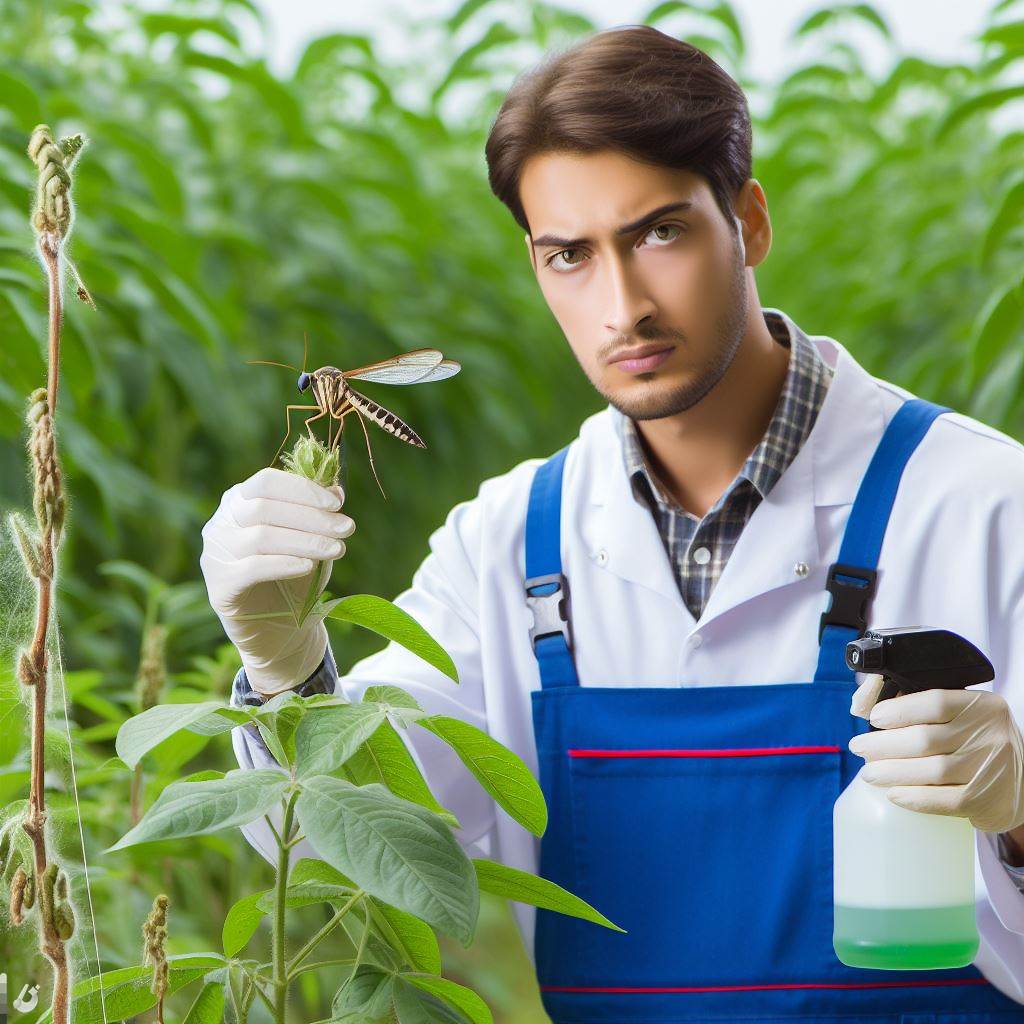Introduction
Soil moisture management plays a vital role in agricultural productivity and water conservation.
Proper soil moisture management is essential to ensure that crops receive the required amount of water for optimal growth and development.
By effectively managing soil moisture, farmers can avoid under or over watering their crops, reducing water wastage and improving water use efficiency.
It helps to enhance crop yield and quality while reducing the risk of crop diseases and pests.
One of the key benefits of soil moisture management is the prevention of soil erosion.
When the soil retains adequate moisture, it becomes more resistant to erosion caused by wind or water.
This helps to maintain soil structure, preventing loss of topsoil and ensuring long-term soil health.
Moreover, soil moisture management techniques also contribute to conserving water resources.
By adopting practices such as mulching, drip irrigation, and soil moisture sensors, farmers can monitor and regulate water usage effectively.
This reduces water consumption and eases the pressure on water sources.
In short, soil moisture management is crucial for sustainable agriculture and water conservation.
By implementing effective techniques, farmers can optimize crop production, enhance water use efficiency, and contribute to preserving soil health and water resources.
In the following sections, we will delve into specific soil moisture management practices and their benefits. Stay tuned!
Understanding Soil Moisture
Definition of soil moisture
Soil moisture refers to the water content present in the soil, including both liquid and vapor forms.
To effectively manage soil moisture, it is important to have knowledge of its definition, factors influencing it, and its significance.
Transform Your Agribusiness
Unlock your farm's potential with expert advice tailored to your needs. Get actionable steps that drive real results.
Get StartedSoil moisture is the water content present in the soil, including both liquid and vapor forms.
It plays a vital role in supporting plant health, crop production, and overall ecosystem sustainability.
Several factors influence soil moisture levels, including climate, soil properties, vegetation, slope, drainage, and human activities.
Factors influencing soil moisture
Understanding these factors helps in implementing appropriate strategies to manage and optimize soil moisture.
Climate, specifically temperature and precipitation patterns, has a significant impact on soil moisture.
Regions with high temperatures and limited rainfall tend to have lower soil moisture levels, making it crucial to conserve available water.
Soil properties such as texture, structure, and depth also influence soil moisture. Sandy soils drain water quickly, while clayey soils retain it for longer.
Knowing the soil type allows for better water management.
Vegetation is another important factor as plants influence soil moisture through evapotranspiration and water uptake.
Dense vegetation can reduce soil moisture by increasing water loss through transpiration.
Slope and drainage affect soil moisture by either causing water runoff or waterlogging.
Proper land grading and adequate drainage systems are essential for maintaining optimal soil moisture levels.
Human activities such as irrigation, deforestation, and land use changes significantly impact soil moisture.
Excessive irrigation can lead to waterlogging, while deforestation reduces soil moisture retention due to the removal of trees’ transpiration.
Importance of maintaining adequate soil moisture levels
Maintaining adequate soil moisture levels is vital for various reasons. Firstly, it is essential for plant health and growth.
Insufficient soil moisture can lead to wilting, stunted growth, and decreased yields.
In agriculture, proper soil moisture management is crucial for crop production.
Adequate soil moisture ensures higher yields, better-quality produce, and improved resilience to drought conditions.
Conserving soil moisture also contributes to water conservation efforts.
By maintaining optimal soil moisture, the need for excessive irrigation can be reduced, saving water resources.
Furthermore, adequate soil moisture helps prevent soil erosion.
When soil is well-moistened, it becomes more cohesive, reducing the risk of erosion caused by wind or water.
Proper soil moisture management also facilitates groundwater recharge.
By maintaining a balance between water infiltration and runoff, groundwater reservoirs can be replenished, ensuring a sustainable water supply.
Showcase Your Farming Business
Publish your professional farming services profile on our blog for a one-time fee of $200 and reach a dedicated audience of farmers and agribusiness owners.
Publish Your ProfileIn the face of climate change, maintaining optimum soil moisture levels is vital for resilience.
Well-moistened soil can better withstand dry spells and extreme weather events, ensuring the continued productivity of agricultural systems.
Lastly, maintaining soil moisture supports biodiversity. Adequate moisture levels create suitable habitats for diverse plant and animal species, contributing to the overall health of ecosystems.
In fact, understanding soil moisture is crucial for effective soil moisture management.
By defining soil moisture, identifying influencing factors, and highlighting its importance, we can ensure the sustainable use of water resources, promote agricultural productivity, and support ecosystem resilience.
Read: Soil Structure: Building Blocks of Fertility
Tools for Assessing Soil Moisture Levels
Overview of different methods
- Visual inspection: Assessing soil moisture levels based on appearance and color.
- Handfeel method: Determining soil moisture by feeling and squeezing a small portion of soil.
- Electronic soil moisture sensors: Using specialized sensors to measure soil moisture levels electronically.
Pros and cons of each method
Visual inspection
- Pros: Simple and quick, does not require any additional tools.
- Cons: Subjective and may lead to inaccurate readings, especially for inexperienced individuals.
Handfeel method
- Pros: Provides a hands-on experience, gives a rough estimate of moisture content.
- Cons: Relies heavily on the individual’s judgement and experience, can vary between different people.
Electronic soil moisture sensors
- Pros: Accurate and reliable readings, eliminates human error, provides real-time data.
- Cons: Expensive initial investment, requires calibration and maintenance, may have technical issues.
Recommended tools for different farming scales
Choosing the right tool depends on the size and resources of the farming operation:
Small-scale farming
- Visual inspection and handfeel method are suitable options due to lower cost and simplicity.
- Electronic soil moisture sensors can still be used but may not be cost-effective for small-scale farmers.
Medium-scale farming
- Investing in electronic soil moisture sensors can provide precise measurements and better water management.
- Visual inspection and handfeel method can be used as supplementary tools for quick estimations.
Large-scale farming
- Electronic soil moisture sensors are highly recommended for accurate and efficient soil moisture management.
- Visual inspection and handfeel method can serve as backup methods or for quick verifications.
Choosing the appropriate tool for assessing soil moisture levels ensures effective irrigation and optimal crop growth.
While visual inspection and handfeel method provide basic estimations, electronic soil moisture sensors offer more precise data for informed decision-making.
It is essential for farmers to evaluate their farming scale and budget to determine the most suitable tool to monitor soil moisture levels accurately.
Read: Climate-Smart Soil: Adapting Farm Practices
Efficient Irrigation Techniques
Importance of efficient irrigation
Efficient irrigation is crucial for conserving water and maximizing crop yield.
Different irrigation systems
Surface irrigation
Surface irrigation involves flooding or furrowing the field with water.
Sprinkler irrigation
Sprinkler irrigation uses overhead sprinklers to distribute water over the field.
Drip irrigation
Drip irrigation delivers water directly to the roots of the plants through a network of tubes or pipes.
Pros and cons of each technique
Surface irrigation
- Pros: low cost, easy to implement, suitable for most crops.
- Cons: significant water loss due to evaporation and runoff, uneven water distribution.
Sprinkler irrigation
- Pros: uniform water distribution, adaptable to various terrain, reduces soil erosion.
- Cons: high installation cost, vulnerability to wind drift and evaporation, energy consumption.
Drip irrigation
- Pros: precise water application, minimal evaporation and runoff, reduced weed growth.
- Cons: high initial investment, clogging issues, requires frequent monitoring and maintenance.
Choosing the right irrigation technique for different crops and conditions
The selection of an appropriate irrigation technique depends on factors like crop type, soil characteristics, climate, and water availability.
Surface irrigation is suitable for crops like rice, wheat, and corn, especially in flat areas with ample water supply.
Sprinkler irrigation works well for orchards, vineyards, and field crops on sloping terrain.
Drip irrigation is ideal for high-value crops, fruits, vegetables, and gardens, especially in arid or water-scarce regions.
It is essential to consider factors such as water availability, soil type, and crop water requirements when deciding on the irrigation method.
Additionally, farmers should evaluate the initial investment, operating costs, and long-term benefits of each technique.
In essence, efficient irrigation techniques play a vital role in water management and crop production.
Each irrigation system has its advantages and disadvantages, and the choice must be based on the specific requirements of the crops and the surrounding conditions.
By employing the right irrigation technique, farmers can optimize water usage, minimize resource wastage, and enhance agricultural productivity sustainably.
Read: Crop Diversity: Soil Health Game Changer

Soil Moisture Conservation Methods
Mulching
Mulching is the practice of covering the soil surface with a layer of organic materials like straw or wood chips.
This helps to retain moisture in the soil by reducing evaporation and minimizing weed growth.
Mulching also improves soil fertility, prevents erosion, and regulates soil temperature.
It acts as a protective shield, keeping the soil moist during dry periods and conserving water resources.
Cover cropping
Cover cropping involves planting specific plants during fallow periods to protect and enrich the soil.
These cover crops help to retain moisture in the soil through their extensive root systems.
They also prevent soil erosion, suppress weed growth, and add organic matter to the soil.
Cover cropping can significantly increase soil moisture retention, ensuring a more sustainable water supply.
Conservation tillage
Conservation tillage refers to practices that disturb the soil minimally during crop planting.
This method helps to conserve soil moisture by leaving crop residues on the surface.
It reduces evaporation, encourages earthworm activity, and improves soil structure.
Conservation tillage is an effective way to mitigate water loss and maintain soil moisture levels.
Contour plowing
Contour plowing is a technique that involves plowing parallel to the contours of the land.
This method helps to minimize water runoff and increase soil moisture retention.
By plowing along the contour lines, water is given more time to infiltrate the soil.
Showcase Your Farming Business
Publish your professional farming services profile on our blog for a one-time fee of $200 and reach a dedicated audience of farmers and agribusiness owners.
Publish Your ProfileContour plowing is particularly beneficial in sloping areas where soil erosion and water runoff are common.
Importance of organic matter in soil moisture retention
Organic matter plays a crucial role in retaining soil moisture.
It acts as a sponge, absorbing water and releasing it slowly to plant roots.
Organic matter also improves soil structure, allowing better water infiltration and reducing water runoff.
Nutrient-rich organic matter helps to promote healthy plant growth and increase the water-holding capacity of the soil.
In general, implementing soil moisture conservation methods is essential for sustainable agriculture.
Mulching, cover cropping, conservation tillage, contour plowing, and organic matter management are crucial practices.
These methods help to retain moisture in the soil, prevent erosion, support plant growth, and conserve water resources.
By adopting these practices, farmers can ensure a more efficient and resilient water management system for their crops.
Ultimately, soil moisture conservation plays a vital role in addressing water scarcity and promoting agricultural sustainability.
Read: Soil pH Balance: Key to Sustainable Growth
Best Practices for Soil Moisture Management
Monitoring soil moisture levels regularly
Regularly monitoring soil moisture levels is crucial in effectively managing soil moisture.
- Use a soil moisture meter or sensor to accurately measure the moisture content in the soil.
- Monitor soil moisture at different depths and locations within the field for more accurate data.
- Keep track of the moisture levels over time to detect any trends or changes.
Using weather data to inform irrigation decisions
Weather data can provide valuable information to make informed irrigation decisions.
- Access reliable weather forecasts, including rainfall predictions and evapotranspiration rates.
- Adjust irrigation schedules based on predicted rainfall or high evapotranspiration rates.
- Consider using automated irrigation systems that are connected to weather stations for real-time data.
Proper timing of irrigation
Timing irrigation correctly can optimize water use and prevent soil moisture stress.
- Water the crops early in the day to reduce evaporation losses and allow foliage to dry before night.
- Avoid irrigating during peak evapotranspiration periods to minimize water loss.
- Adjust irrigation frequency and duration based on crop stage and weather conditions.
Proper drainage management
Efficient drainage is essential to prevent waterlogging and maintain optimal soil moisture.
- Ensure proper field drainage systems, including tile drains or ditches, are in place.
- Regularly check and maintain the drainage infrastructure to avoid blockages or ineffective drainage.
- Monitor water table levels to prevent water accumulation and subsequent crop damage.
Crop rotation for soil moisture balance
Crop rotation can help maintain soil moisture balance and prevent excessive moisture depletion.
- Rotate crops with different water requirements to avoid continuous depletion of soil moisture.
- Include moisture-conserving crops, such as legumes or cover crops, in the rotation to enhance soil moisture retention.
- Plan crop rotations based on soil moisture needs and consider the impact on overall water management.
Importance of farmer experience and intuition
Farmer experience and intuition play a vital role in effective soil moisture management.
- Farmers’ experience with their specific field conditions can guide irrigation decisions.
- Intuition developed over time helps farmers interpret weather data and make appropriate adjustments.
- Collaborate with experienced farmers and learn from their knowledge and practices.
Implementing these best practices for soil moisture management can significantly improve water use efficiency and crop productivity.
By monitoring soil moisture, utilizing weather data, timing irrigation properly, managing drainage, employing crop rotation, and valuing farmer experience, farmers can optimize irrigation decisions and ensure sustainable soil moisture levels.
Conclusion
Throughout this article, we have explored the essential aspects of soil moisture management and its importance in agriculture.
We have learned that:
- soil moisture is vital for plant growth and plays a crucial role in determining crop yield;
- improper soil moisture management can lead to water scarcity, reduced productivity, and economic losses;
- implementing efficient irrigation techniques, such as drip irrigation and precision agriculture, can help optimize soil moisture;
- monitoring soil moisture levels using advanced technologies and sensors enables farmers to make informed decisions;
- conservation strategies like rainwater harvesting and mulching contribute to sustainable water use and enhance soil moisture balance.
As farmers, it is crucial to recognize the significance of soil moisture management for long-term agricultural success.
By adopting effective practices such as proper irrigation scheduling, use of soil moisture meters, and implementing conservation techniques, farmers can:
- save water resources,
- reduce production costs,
- maximize crop yields, and
- contribute to sustainable agriculture.
Therefore, I encourage all farmers to prioritize soil moisture management and explore the available resources and technologies that can help improve their practices.
Water wisdom in agriculture is not merely an option but a necessity.
By making informed decisions and implementing effective soil moisture management techniques, farmers can overcome the challenges of water scarcity, enhance crop yields, and ensure a sustainable future for agriculture.
Let us embrace water wisdom and pave the way for a prosperous agricultural sector.




